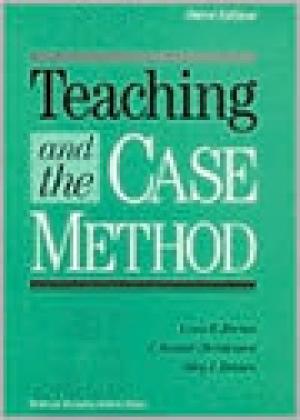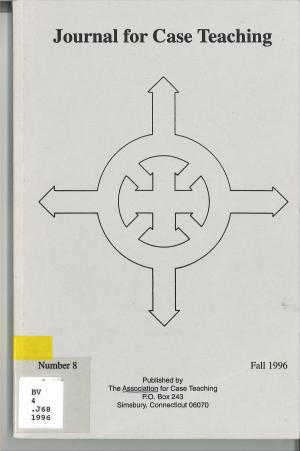Resources
One page Teaching Tactic: using a series of case studies through the semester in a Christian Education classroom.

Gives an abundance of practical advice on how active learning techniques can be used by teachers across the disciplines. Using real-life examples, the authors discuss how various small-group exercises, simulations, and case studies can be blAnded with the technological and human resources available outside the classroom. The book is engagingly written for all classroom teachers. (From the Publisher)

CTI Resource Notebook compiled by Jeanene Reese for the 35th annual Summer Institute at the School of Theology and Ministry, Seattle University, 2006. (From the Publisher)
Journal Issue.

This monograph explores practical and theoretical issues in use of case studies for college faculty to reflect on and improve instruction. Six chapters: (1) describe teaching case studies, with an overview of how and why they are used; (2) explore the rationale for their use within the frameworks of scholarship and professional development; (3) present three brief case studies and suggestions for their use in discussion; (4) present reports from faculty groups who have written case studies, with their suggestions on how to proceed; (5) discuss nine issues that have emerged through the use of cases (how they can place the focus on learning as well as teaching, possible alternative formats, getting at the more subtle issues of practice, going beyond problems to the problematic, whether and how cases can represent best practice, including content issues, using cases to build on one another, creating occasions for more productive use of cases, and the impact of case use on teaching improvement); and (6) describe three possible scenarios illustrating how cases might contribute to a campus culture that takes teaching and learning seriously. Four additional cases and teaching suggestions are appended as is a list of 13 resource organizations. (From the Publisher)

Using Cases in Higher Education: A Guide for Faculty and Administrators is an essential resource created for faculty and administrators who utilize case studies to analyze, assess, and respond to the complex and difficult issues facing higher education leaders. While this volume will prove useful with any case study, it is specifically designed to complement the series of casebooks and teaching notes, starting with Casebook I: Faculty Employment Policies and Teaching Notes to Casebook I: Faculty Employment Policies. (From the Publisher)

Drawing on experiences from a range of fields, including public administration, policy analysis, law, teacher training, ethics, and undergraduate education, this book is intended to be a practical, process-oriented guide to teaching, writing, and learning with cases. The guide is organized into four parts: (1) "Teaching with Cases: Principles" (concerned with the different meanings of the term "case method" in various domains of teaching, with sources of resistance to case teaching, and with strategic issues teachers face in deciding what and how to teach); (2) "Teaching with Cases: Techniques" (concerned with the practice of case teaching ranging from the basics to the more advanced "tricks of the trade" practiced by experienced instructors; content could be covered in a case teaching workshop of three to five days in length); (3) "Curriculum Planning" (describes the types of cases available and provides guidelines for selecting appropriate cases to use for teaching); (4) "Case Writing" (approaches case writing as the subject might be handled in a case writing workshop designed to produce usable new cases). An appendix contains a teaching case, a teaching note, and a case analysis. References include a selected bibliography of case teaching and case learning guides and literature, case catalogs, and on-line resources. (From the Publisher)

This third edition of Teaching and the Case Method is a further response to increased national and international interest in teaching, teachers, and learning, as well as the pressing need to enhance instructional effectiveness in the widest possible variety of settings. Like its predecessors, this edition celebrates the joys of teaching and learning at their best and emphasizes the reciprocal exchange of wisdom that teachers and students can experience. It is based on the belief that teaching is not purely a matter of inborn talent. On the contrary, the knowledge, skills, and attitudes that make for excellence in teaching can be analyzed, abstracted, and learned. One key premise of Teaching and the Case Method is that all teaching and learning involve a core of universally applicable principles that can be discerned and absorbed through the study and discussion of cases. (From the Publisher)

Journal Issue.